CSPA |
| Your 501(c)(3) tax deductible cash donations are desperately needed if the fight for our fisheries is to continue. Read how you can donate! |
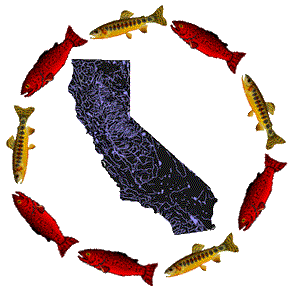
 More News
More News
![]()
 Egg transfer never occurred, Mokelumne hatchery still at 290,000 while capacity is 9,000,000: A river in need of friends
Egg transfer never occurred, Mokelumne hatchery still at 290,000 while capacity is 9,000,000: A river in need of friends
by Jerry Neuburger
January 27, 2009 -- While the Department of Fish and Game issued a news release on December 30, in which Walt Beer, DFG Hatchery Coordinator stated, “The unprecedented low adult return to Mokelumne River Hatchery will severely restrict their production. Some eggs in excess of Nimbus’s goal will be transferred to Mokelumne after normal losses in hatchery processes are accounted for,” the transfer of those eggs never occurred.
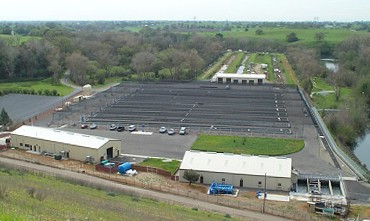 |
| The Mokelumne hatchery at the base of Camanche Dam |
The Mokelumne Hatchery's egg count still stands at 290,000, about 3% of its capacity. The need for additional eggs became obvious when it became apparent that the hatchery would not meet its goal from returning fish.
This year, only 236 female salmon returned to the hatchery while the "average" Mokelumne run since 1996 has been about 5,500. In 2002, a banner year, over 10,700 fish returned but the number has been dwindling ever since.
The river has a long and sometime melancholy history. Old time farmers from the 1930's remember when they could back their pickups into the river and load chinook salmon into the beds using pitchforks. One old sodbuster told me, "The salmon were so thick there was no room for water in the river. We could load 'em up for eaten' and even had enough ...(Continued) to feed 'em to the pigs."
The river, which for short time in the 1860's flowed deep enough to operate a small steamboat from Woodbridge to Lockeford, did however have some serious problems. The first threat to the river was the Penn Mine. The mine, operated on and off until after WWII, released a chemical soup into the river. This soup contained, "pH values between 2.3 and 2.8 and high concentrations of sulfate and metals including aluminum, cadmium, copper, iron, and zinc."
Fish kills were not uncommon in the river because of this run-off which occurred at different levels depending on activity at the mine and annual rainfall. In the late 70's and early 90's some attempts were made to clean up the area, install impoundments and treat the run-off. However, a 1996 USGS report states that, "the impoundment has since been allowed to resume its untreated condition."
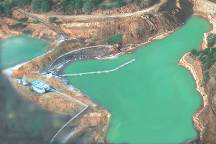 |
| Penn mine run-off, a toxic soup |
The runoff from the mine's impoundment barrier, Mine Run Dam empties into Camanche Reservoir. "Discharge toward Camanche Reservoir within the acidic groundwater plume at the base of Mine Run Dam is estimated to be about 40 cubic feet (300 gallons) per day," and estimated to contain, " 17 grams of copper per day, 250 grams of zinc per day, and 2.7 grams of cadmium per day."
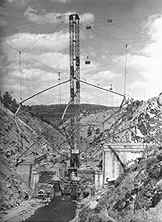 |
| Pardee under construction, 1928 |
The second blow was East Bay Municipal District construction of Pardee Dam in 1929 and Camanche Dam, built in 1963. Pardee, built first, was constructed to remove the threat of drought in the east bay. When the spigots were opened, "[W]orkmen knocked out bulkheads to set the water flowing down the pipeline at long last. All that night it crept like a caged liquid serpent down from the foothills and across the valleys, over the Delta peat lands and into the Walnut Creek pumping plant. At 4 p.m. on Sunday, June 23, 1929, the head of the stream dipped into San Pablo Reservoir and began to spread. It wasn't a moment too early. At long, long last, all danger of water famine in the East Bay was lifted." Its Name Was M.U.D.: A Story of Water (Ida McClendon, ed., 1999).
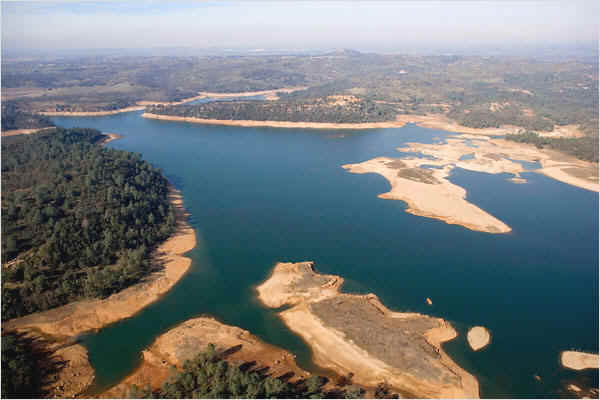 |
| Camanche Reservoir in the fall, photo courtesy of UC Berkeley |
Camanche Dam, again owned by EBMUD, was finished in 1963. The dam was built for different purposes, flood control, irrigation and hydro-electric power being the reasons for its construction. When completed, this dam cut off almost all of the historic spawning areas for the river's once voluminous chinook salmon and steelhead runs. As mitigation, EBMUD funded the building and operation of the DFG operated Mokelumne River Fish Hatchery.
When the dam was constructed, some things were not considered in regards to fish, especially the temperature of the water being released into the lower river during the dam's normal operations. Because of this, a series of fish kills occurred when release water temperatures exceeded 75 degrees, usually in late summer. These kills would affect hatchery operations and native salmonids in the river including resident rainbows, returning steelhead and chinook salmon smolts.
A major fish kill in the river in the late 1980's coupled with a chinook salmon return of only 12 females to the hatchery became the impetus for a grass roots effort to restore the river to health and the Committee to Save the Mokelumne was born. Through a series of spaghetti feeds, barbecues, and other fund raising efforts, the Committee, under the guidance of Bill Jennings, now CSPA Executive Director, raised enough money to sue EBMUD over the uncontrolled run-off from Penn Mine in federal court and deal with EBMUD and Woodbridge Irrigation District as to the necessary modifications to the release mechanism at Camanche Dam, the upgrade of spawning gravels in the small area left for natural spawning and the construction of a new, more efficient fish ladder at Woodbridge Dam, a small dam in the City of Lodi, operated by the Woodbridge Irrigation District.
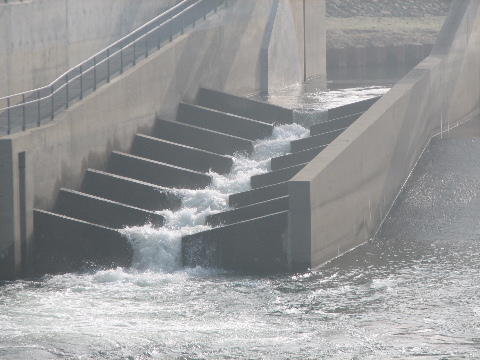 |
| The new fish ladder at Woodbridge Dam. Total flow of dam. Photo by Jerry Neuburger |
An agreement was finally reached in the work necessary to modify facilities and improve operation. In addition, a release schedule was worked out assuring that enough water would be released below Camanche and Woodbridge dams during the spawning season so that the river's abundant chinook salmon runs could again return. While the agreement was not everything that the Committee wanted, and a request for a rehearing was submitted, the improvements proved to be dramatic in the river's recovery. Because of the parties adherence to the agreement and the implementation of the various river improvements, salmon returns skyrocketed. In 1998 a "wet" year, 7213 salmon entered the upper river above Woodbridge Dam, in 1999 a "wet" year, 5,335. in 2000, an "above normal" year, 7,418, in 2001, a "dry" year, 8,114, in 2002, a second "dry" year, 10,757, in 2003, an "above normal" year, 10,241. Salmon return numbers then began to fall off. In 2006, a "wet" year, 5,839 chinook salmon entered the Mokelumne above Woodbridge dam. Then things turned BAD. In 2007, a "dry" year, only 1500 salmon returned. Even so, this minimal return was enough to stock the hatchery. This year, 2008, the bottom has fallen out. The year has been classified as, "critically dry." The number of salmon returning to the hatchery was the lowest count in ten years, 236. The result is a hatchery with only 290,000 eggs, or three percent of its goal of nine million. With the situation so grave some questions need to be answered. Why did DFG claim to supply additional eggs to the Mokelmune hatchery when no such transfer occurred? Perhaps it was an overly optimistic statement made without full knowledge of what was happening at the Nimbus hatchery. Maybe just political hype in the face of a irate fishing community. If so, the claimed transfer was spoken out of turn. Why have the returns on the Mokelumne fallen to precipitously low levels in such a short period of time? While it appears from release records that the parties to the agreement, Woodbridge Irrigation and EBMUD have at least come close to meeting their agreed obligations, more work needs to be done to assure that such is the case. Why has there been no effort by DFG to examine the crash in returning salmon to the hatchery? Lack of funds? Lack of interest? Lack of personnel? Political maneuvering? These answers will not come easily and certainly not from DFG, the supposed stewards of our fisheries. It looks like it will take a grass roots effort to find the answers and solve the river's problems. It looks like it's time to call back the old warriors of the Committee To Save the Mokelumne for another round in the "water wars" ring. They scored a knockdown in the previous round but it looks like the opponent has struggled to his feet and is again a threat to the river and its fisheries. Bill Jennings, we need you to call the troops to assemble, the Committee to Save the Mokelumne is badly needed again.